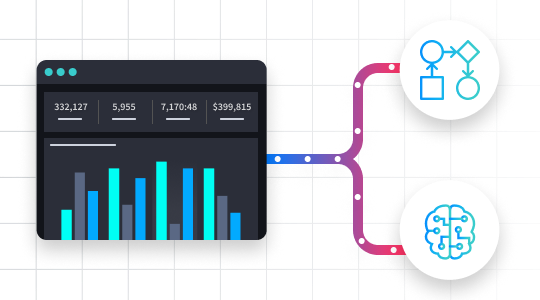Guide to Risk-Based Prioritization: Understanding Types and Key Factors
Cybersecurity resources are finite, but threats are limitless. Not all risks carry the same weight, and treating them equally only stretches your defenses thin. That’s where risk-based prioritization proves indispensable. It equips security operations (SecOps) teams to focus time and budget on the risks most likely to jeopardize critical systems, disrupt business continuity, or erode brand trust.
What is Risk-Based Prioritization?
Risk-based prioritization is a strategic approach that allows organizations to rank identified risks based on their potential impact and likelihood of occurring. Instead of treating all risks equally, this methodology focuses on understanding the true exposure a risk presents to the business, enabling security teams to allocate resources and efforts where they will have the greatest protective effect.
For security operations (SecOps) teams, this means moving beyond simply patching every vulnerability or investigating every alert. It’s about intelligently assessing which cyber risks pose the most significant threat to critical assets, business continuity, and organizational reputation.
Understanding the 3 Different Levels of Cyber Risk Prioritization
Prioritization isn’t one-dimensional. It functions across interconnected layers:
- Strategic: Aligns security initiatives with overarching business goals and regulatory obligations. This might guide multi-year investments or major policy changes.
- Operational: Manages risks that can directly disrupt live systems and daily workflows, such as patch management and incident containment.
- Tactical: Zeroes in on the day-to-day, triaging alerts, hunting emerging threats, and making snap decisions to protect sensitive data.
Each level requires its own lens, yet all converge to strengthen your security posture.
Key Factors Influencing Effective Cyber Risk Prioritization
In a cybersecurity strategy, an effective risk prioritization isn’t solely about impact and likelihood. A holistic approach considers several interwoven factors that provide a more accurate picture of a risk’s true significance and manageability.
Impact and Likelihood (Severity)
This forms the bedrock of most risk assessments.
- Impact: What is the potential consequence if this risk materializes? This can range from financial losses and operational downtime to reputational damage, legal penalties, or data breaches. Understanding the specific business assets affected and their value is critical.
- Likelihood: How probable is it that this risk will occur? This involves assessing the threat landscape, existing vulnerabilities, and the effectiveness of current controls. A high-impact, high-likelihood risk naturally demands top priority.
Cost of Inaction vs. Remediation
Prioritization often comes down to a cost-benefit analysis.
- Cost of Inaction: What are the potential financial and non-financial repercussions if this risk is not addressed? This includes direct costs (fines, recovery expenses) and indirect costs (loss of customer trust, decreased productivity).
- Cost of Remediation: What resources (money, time, personnel) will be required to mitigate or eliminate this risk? Sometimes, a high-impact risk might have a disproportionately low remediation cost, making it an efficient target for prioritization.
Resource Constraints & Availability
- Personnel: Do you have the skilled analysts, engineers, or responders available to address the risk?
- Time: Is there a critical window for remediation before the risk escalates?
- Budget: Are the necessary tools, technologies, or external services within your financial reach? Prioritization must be realistic, aligning with what your team can genuinely achieve.
Manageability and Control Effectiveness
- Manageability: How difficult or complex is it to mitigate this specific risk? Can it be addressed quickly with existing tools, or does it require significant system changes or specialized expertise?
- Control effectiveness: Are there existing security controls in place (e.g., firewalls, EDR, access controls)? How well are they performing? A high-impact risk with ineffective controls will naturally be a higher priority than one protected by robust, well-maintained defenses.
Threat Landscape & Urgency
The cybersecurity landscape is dynamic, with new threats emerging constantly.
- Current Threat Landscape: Are there active exploits targeting this type of vulnerability? Is there an active campaign from a known threat actor?
- Urgency: Is this a time-sensitive risk that needs immediate attention (e.g., a newly discovered zero-day, an active incident)? Understanding the real-time context of threats is vital for effective prioritization.
How to Build a Cyber Risk Prioritization Matrix
A risk prioritization matrix is a visual tool that helps security teams quickly assess and compare different risks based on their impact and likelihood. While formats can vary, the core concept remains the same: mapping risks onto a grid to categorize their severity and guide prioritization decisions.
Typically, a matrix is a simple 2×2, 3×3, or 5×5 grid where one axis represents Impact (e.g., Low, Medium, High) and the other represents Likelihood (e.g., Rare, Unlikely, Possible, Likely, Certain).
Here’s a simplified approach to creating one:
- Define your scales: Establish clear definitions for each level of impact and likelihood. For instance, “High Impact” could mean “direct financial loss over $1M or significant reputational damage.” “Likely” could mean “expected to occur at least once a year.”
- Identify your risks: List all the cyber risks your organization faces, from unpatched vulnerabilities to potential phishing attacks or insider threats.
- Assess each risk: For each identified risk, determine its potential impact and likelihood of occurrence based on the factors discussed above.
- Plot on the matrix: Place each risk onto the matrix based on its assessed impact and likelihood.
- Assign priority levels: The quadrants of the matrix will naturally suggest priority levels:
- High Impact / High Likelihood: Critical (Immediate action required)
- High Impact / Low Likelihood: Major (Plan for mitigation, monitor closely)
- Low Impact / High Likelihood: Minor (Address as resources allow, may accept)
- Low Impact / Low Likelihood: Negligible (Monitor, often accepted)
This visual representation makes it easier to communicate risk levels across the team and to stakeholders, ensuring everyone understands where resources should be focused.
Example of Screening and Prioritizing Risk
Imagine your vulnerability scanner flags 500 new vulnerabilities this week. How do you decide where to start?
- Initial screening: Immediately filter for critical vulnerabilities and prioritize those affecting highly critical assets (like public-facing web servers). Also, check if there are known active exploits for these vulnerabilities.
- Prioritization in action:
- Top priority: An unpatched, critical vulnerability on a public-facing web server with active exploits would be a Critical risk, demanding immediate attention due to high impact and high likelihood.
- Lower priority: A medium-severity vulnerability on an internal development server would be Minor/Moderate, addressed when resources allow, given its limited impact and internal exposure.
By quickly screening and applying these factors, your SecOps team can efficiently pinpoint and tackle the most pressing risks first, even amidst hundreds of alerts.
How to Ensure Smarter Risk Prioritization in Security Operations?
Smarter risk prioritization requires more than manual analysis or static playbooks. It means aligning security efforts with what truly puts your business at risk, factoring in impact, likelihood, urgency, and available resources.
Swimlane’s AI automation platform makes this possible by continuously ingesting and analyzing data across your security ecosystem, then applying your unique business logic to surface the highest-priority threats. This helps security teams reduce mean-time-to-detect and respond, cut through alert noise, and focus on incidents that matter most.
By automating data collection, enrichment, and decision-making, Swimlane ensures your risk prioritization adapts in real time to evolving threats and business demands, so your security operations stay both proactive and aligned to what’s critical.
TL;DR: Risk Prioritization
TL;DR: Risk-based prioritization helps security teams focus on the most impactful cyber threats by assessing their likelihood and severity. This guide covers different prioritization levels, key influencing factors like cost and resources, how to use a prioritization matrix, and a practical example to help you strengthen your security operations.

A Buyer’s Guide for Modern Security Automation
Enterprise SOC teams recognize the need for automation but often struggle with the automation solutions themselves. Security Orchestration, Automation and Response (SOAR) solutions commonly require extensive scripting. No-code automation solutions are simplistic and lack necessary case management and reporting capabilities. This guide analyzes the wide range of security automation platforms available today, so you can identify the type of solution that fits your needs the best.


